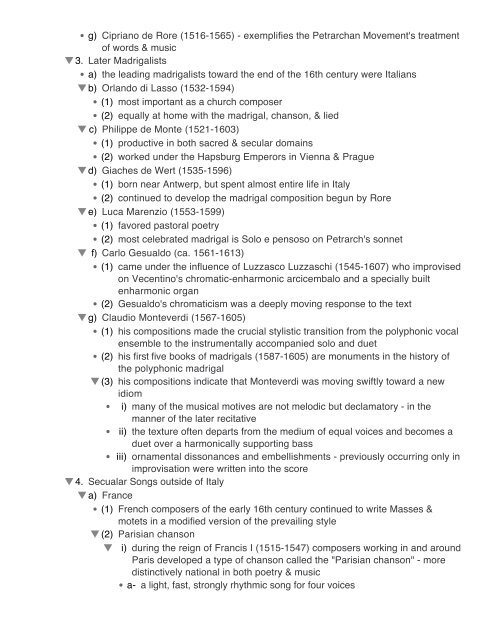An Outline of The History of Western Music Grout ... - The Reel Score
An Outline of The History of Western Music Grout ... - The Reel Score
An Outline of The History of Western Music Grout ... - The Reel Score
You also want an ePaper? Increase the reach of your titles
YUMPU automatically turns print PDFs into web optimized ePapers that Google loves.
g) Cipriano de Rore (1516-1565) - exemplifies the Petrarchan Movement's treatment<br />
<strong>of</strong> words & music<br />
3. Later Madrigalists<br />
a) the leading madrigalists toward the end <strong>of</strong> the 16th century were Italians<br />
b) Orlando di Lasso (1532-1594)<br />
(1) most important as a church composer<br />
(2) equally at home with the madrigal, chanson, & lied<br />
c) Philippe de Monte (1521-1603)<br />
(1) productive in both sacred & secular domains<br />
(2) worked under the Hapsburg Emperors in Vienna & Prague<br />
d) Giaches de Wert (1535-1596)<br />
(1) born near <strong>An</strong>twerp, but spent almost entire life in Italy<br />
(2) continued to develop the madrigal composition begun by Rore<br />
e) Luca Marenzio (1553-1599)<br />
(1) favored pastoral poetry<br />
(2) most celebrated madrigal is Solo e pensoso on Petrarch's sonnet<br />
f) Carlo Gesualdo (ca. 1561-1613)<br />
(1) came under the influence <strong>of</strong> Luzzasco Luzzaschi (1545-1607) who improvised<br />
on Vecentino's chromatic-enharmonic arcicembalo and a specially built<br />
enharmonic organ<br />
(2) Gesualdo's chromaticism was a deeply moving response to the text<br />
g) Claudio Monteverdi (1567-1605)<br />
(1) his compositions made the crucial stylistic transition from the polyphonic vocal<br />
ensemble to the instrumentally accompanied solo and duet<br />
(2) his first five books <strong>of</strong> madrigals (1587-1605) are monuments in the history <strong>of</strong><br />
the polyphonic madrigal<br />
(3) his compositions indicate that Monteverdi was moving swiftly toward a new<br />
idiom<br />
i) many <strong>of</strong> the musical motives are not melodic but declamatory - in the<br />
manner <strong>of</strong> the later recitative<br />
ii) the texture <strong>of</strong>ten departs from the medium <strong>of</strong> equal voices and becomes a<br />
duet over a harmonically supporting bass<br />
iii) ornamental dissonances and embellishments - previously occurring only in<br />
improvisation were written into the score<br />
4. Secualar Songs outside <strong>of</strong> Italy<br />
a) France<br />
(1) French composers <strong>of</strong> the early 16th century continued to write Masses &<br />
motets in a modified version <strong>of</strong> the prevailing style<br />
(2) Parisian chanson<br />
i) during the reign <strong>of</strong> Francis I (1515-1547) composers working in and around<br />
Paris developed a type <strong>of</strong> chanson called the "Parisian chanson" - more<br />
distinctively national in both poetry & music<br />
a- a light, fast, strongly rhythmic song for four voices





